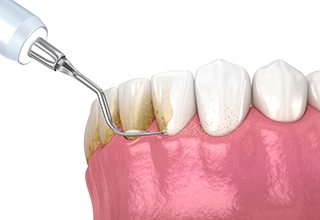Gum Disease Treatment – Owasso, OK
We Treat More Than Just Teeth

When it comes to your dental health, you’re probably primarily worried about your teeth, but you need to pay attention to your gums as well. Gum disease can easily develop without you realizing it, and if it isn’t treated in time, it could leave you with gaps in your smile. Dr. Voto and the rest of our team can screen for gum disease during one of your routine checkups, and they can take steps to treat it before it can grow more severe. Call us today if you would like to learn more about how gum disease treatment works at our office!
Why Choose Jayson D. Voto, DDS for Gum Disease Treatment?
- Thorough Scaling and Root Planing
- Customer-Service Oriented Office
- Trustworthy and Honest Dentist
What is Gum Disease?

Gum disease occurs when the soft tissues around your teeth suffer from an infection. The earliest stage of gum disease is called gingivitis; over time, it can eventually turn into a more serious condition known as periodontitis. Gingivitis can often be reversed by taking better care of the teeth and gums, but periodontitis cannot be fully cured and must be managed.
When left alone, periodontitis can lead to the loss of permanent teeth; it could also potentially raise your risk for heart attacks and other cardiovascular problems.
Symptoms of Gum Disease

Are your gums unusually red or swollen? Do you often find blood on your toothbrush or dental floss? Do your teeth appear to be longer? Has there been a change in your bite? Do any of your permanent teeth feel loose? All of these are potential warning signs of gum disease.
Of course, it’s important to keep in mind that gum disease sometimes doesn’t have any obvious symptoms at first. Your dentist can take a look at the state of your gums during your next checkup.
How Do We Treat Gum Disease?

Examining your mouth is the first step. We’ll take note of how severe your condition is and how much damage has already been done. Then we will work with you to create a treatment plan. It’s important that you understand the specifics of the care that you receive, so please don’t hesitate to speak up if you have any questions or concerns about the services we use to address gum disease.
Scaling & Root Planing

The plaque and tartar contributing to gum disease often hide beneath the gumline, making them difficult to remove with a traditional dental cleaning. As such, scaling and root planing are often recommended for treating gum disease. With scaling, the plaque and tartar around and below the gums will be carefully removed. Then root planing will be performed; this simply involves smoothing out the roots of your teeth. This is done because smoother tooth roots will allow the gums to reattach themselves more firmly.
